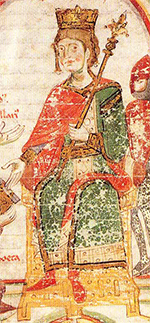Henry VI: King of Germany, Holy Roman Emperor
Henry VI was King of Germany and Holy Roman Emperor in the latter half of the 12th Century. At its height, his realm was one of the largest ever in the empire. 
He was born in November 1165 in Nijmegen. His father was Frederick Barbarossa, and his mother was Beatrice of Burgundy. When Henry was just 4, he took the crown as King of the Romans (King of Germany). A handful of years later, the still young Henry went with his father to Italy and studied law, statesmanship, and Latin. He also at an early age developed a love of music and poetry and is known to have written a number of songs and poems. Henry married Constance of Sicily on Jan. 27, 1186, in Milan. Her father was the powerful King Roger II of Sicily. Henry's father died on the Third Crusade, in 1190, and Henry took over the kingdom, having only just secured a halt in fighting with Henry the Lion, an enemy of his father. In 1191, Henry VI marched at the head of an army into Italy. He was crowned Holy Roman Emperor on April 15, 1191. After finding frustration in a fight over succession to the throne of Sicily (thanks in part to an outbreak of the plague), he hurried back to Germany to confront yet another rebellion by Henry the Lion. A reluctant emperor came to terms again with the malcontent. Henry's wife, Constance, had been taken prisoner in Sicily and freed through the intercession of Pope Celestine III. The pope's requirement was that Henry give up his claim to Sicily in favor of Tancred of Lecce, who was the people's favorite. Constance was the daughter of the beloved Roger II. Tancred was Roger's son, but the boy's mother was not Roger's wife. So technically, Constance's claim was stronger. Nonetheless, Tancred was the people's favorite. 
In 1193, Duke Leopold V of Austria came calling with a prominent prisoner, King Richard I of England. That monarch had been captured on his way home from the Third Crusade. His alliance with Tancred, Henry's enemy, had angred Henry, and the emperor held Richard at Trifels Castle and set a very high price for his release. Richard's mother, Eleanor of Aquitaine, organized the payment and, as a requirement of Richard's release, made the English king bow in submission to the Holy Roman Emperor and aid in Henry's campaign in Sicily. 
The following year saw Henry again in Italy, this time finally achieving his goal of taking the crown of Sicily. His arch-enemy Tancred had died, leaving a young boy as heir. By that time, support for Tancred had dwindled, and Henry found it easy enough to claim ownership of Sicily. That made the extent of his domains quite large, and the emperor made noises of attacking both the Republic of Venice and the Byzantine Empire; neither enterprise panned out, and Henry returned to Germany to ensure an orderly succession. His son, Frederick, had been born in 1194, the day after he was crowned King of Sicily. Henry proposed to make the imperial crown again hereditary, as it had been in Carolingian times. A majority of Henry's princes at first approved but then ultimately rejected the idea; however, they still elected young Frederick King of the Romans when he was 2. Henry hadn't given up on his plans to expand his influence beyond Italy and returned there in 1197. Discontent that had been simmering broke out into open revolt, and Henry had to yet again agree to stop the fighting. He fell ill (some accounts say with malaria) and died in Messina, on September 28. His death created a succession crisis that resulted in the crowning of two successors, Philip (his brother) and Otto. |
|
Social Studies for Kids
copyright 2002–2025
David White




